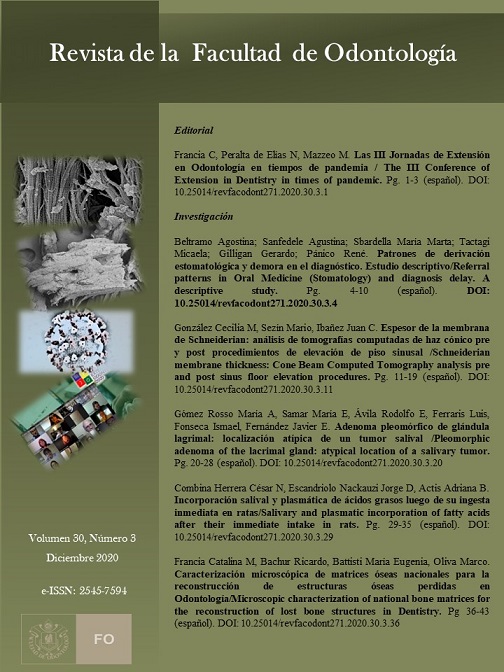Microscopic characterization of national bone matrices for the reconstruction of lost bone structures in Dentistry
Keywords:
scanning electron microscope, bone matrix, rehabilitationAbstract
Objective. Morphologically characterize the ultrastructure of some nationally manufactured bone matrices available in the local commercial market in order to determine the main characteristics that allow their use in the dental rehabilitation of atrophic bone ridges. Methods. Bone matrices from Freeze-Dried Human Bone (HHL) provided by the Laboratory of Blood Products of the National University of Córdoba were studied, with block and powder format whose particle size is from 200 to 1000 μm and in the form of fine granules of 1000 at 2000 μm. The samples were respectively metalized with a layer of gold or chromium and were analyzed in a scanning electron microscope (SEM). Results. A structure of HHL bone similar to that observed in the spaces of the Haversian blood vessel system of normal human bone was observed. Conclusions. The structural findings of the HHL bone, similar to those observed in the spaces of the Haversian blood vessel system of normal human bone, guarantee the topographic conservation responsible for the increase of the surface area and consequently a large surface-volume ratio that favors repair and regeneration. Bone with favorable characteristics is used as a graft. In addition, maintaining the nanostructure of the extracellular matrix gives it greater roughness, allowing greater anchorage that favors better cell growth by presenting essential topographic signals, benefiting adhesion, proliferation and differentiation of cells
Downloads
References
Gómez de Ferraris ME, Campos Muñoz A. Periodoncio de Inserción: Cemento, Ligamento Periodontal y Hueso Alveolar. En: Histología y Embriología Bucodental. Ed Médica Panamericana. Madrid, 2002: 2ª ed., pp 368-83.
Hof M, Tepper G, Semo B, Arnhart C, Watzek G, Pommer B. Patients’ perspectives on dental implant and bone graft surgery: questionnaire-based interview survey. Clin. Oral Impl. Res., 2012, 1–4.
Misch Carl E. Rationale for Dental Implants- Anatomical Consequences of Edentulism. En: Dental Implant Prosthetics. Elsevier Health Sciences, 2014: 2 ª ed., pp 10-23.Traini et al, 2015
Brekke J, Toth J. Principles of Tissue Engineering Applied to Programmable Osteogenesis. J. Biomed. Mater. Res. (Appl Biomater), 1998, 43:380-98.
Weibrich G, Götz H, Gnoth S-H, Trettin R, Duschner H, Wagner W. Charakterisierung der Oberflächenmorphologie von Knochenersatzmaterialienmittels REM. Z Zahnärztl Implantol: 2000: 16: 151-159.
ThaKral GK, ThaKral Rashmi, Sharma N, Jyotsana S, Vashish P. Nano surface – The Future of Implants. Journal of Clinical and Diagnostic Research. 2014 May, Vol-8(5): 7-10]
Rani, V.V.; Vinoth-Kumar, L.; Anitha, V.C.; Manzoor, K.; Deepthy, M.; Shantikumar, V.N. Osteointegration of titanium implant is sensitive to specific nanostructure morphology. Acta Biomater. 2012, 8, 1976–1989.
Wang, X.; Gittens, R.A.; Song, R.; Tannenbaum, R.; Olivares-Navarrete, R.; Schwartz, Z.; Chen, H.; Boyan, B.D. Effects of structural properties of electrospun TiO2 nanofiber meshes on their osteogenic potential. Acta Biomater. 2012, 8, 878–885.
Perán M, García M A, Lopez-Ruiz E, Jiménez G, and Marchal JA. How Can Nanotechnology Help to Repair the Body? Advances in Cardiac, Skin, Bone, Cartilage, and Nerve Tissue Regeneration. Materials 2013, 6(4), 1333-1359.
Alpaslan E, Webster T J. Nanotechnology and pico technology to increase tissue growth: a summary of in vivo studies. Short report. International Journal of Nanomedicine 2014:9 (Suppl 1) 7–12.
Kearney J.N. Sterilization on human tissue implants, British Asociation of Tissue Bank 1996 Newsletter 6, 2-5.
Bailey A.J. Effect of ionizing radiation on connective tissue components. En: International Review of Connective Tissue Research, D.A. 1968. Hall, ed. Academic Press. New York vol 4.
Houben J.C. Free radical produced by ionizing radiation in bone and its constituents. International Journal of Radiation Biology. 1971, 20: 373-389.
Dziedzig-Goclawska A. Aplicación de la radiación ionizante para esterilizar aloinjertos de tejido conectivo. En: radiación y operación de Banco de Tejidos, ed. Printing Services AC. Peru, 2002.
Downloads
Published
Issue
Section
License

This work is licensed under a Creative Commons Attribution-NonCommercial-ShareAlike 4.0 International License.
Aquellos autores/as que tengan publicaciones con esta revista, aceptan los términos siguientes:
- Los autores/as conservarán sus derechos de autor y garantizarán a la revista el derecho de primera publicación de su obra, el cuál estará simultáneamente sujeto a la Licencia de reconocimiento de Creative Commons que permite a terceros:
- Compartir — copiar y redistribuir el material en cualquier medio o formato
- La licenciante no puede revocar estas libertades en tanto usted siga los términos de la licencia
- Los autores/as podrán adoptar otros acuerdos de licencia no exclusiva de distribución de la versión de la obra publicada (p. ej.: depositarla en un archivo telemático institucional o publicarla en un volumen monográfico) siempre que se indique la publicación inicial en esta revista.
- Se permite y recomienda a los autores/as difundir su obra a través de Internet (p. ej.: en archivos telemáticos institucionales o en su página web) después del su publicación en la revista, lo cual puede producir intercambios interesantes y aumentar las citas de la obra publicada. (Véase El efecto del acceso abierto).

